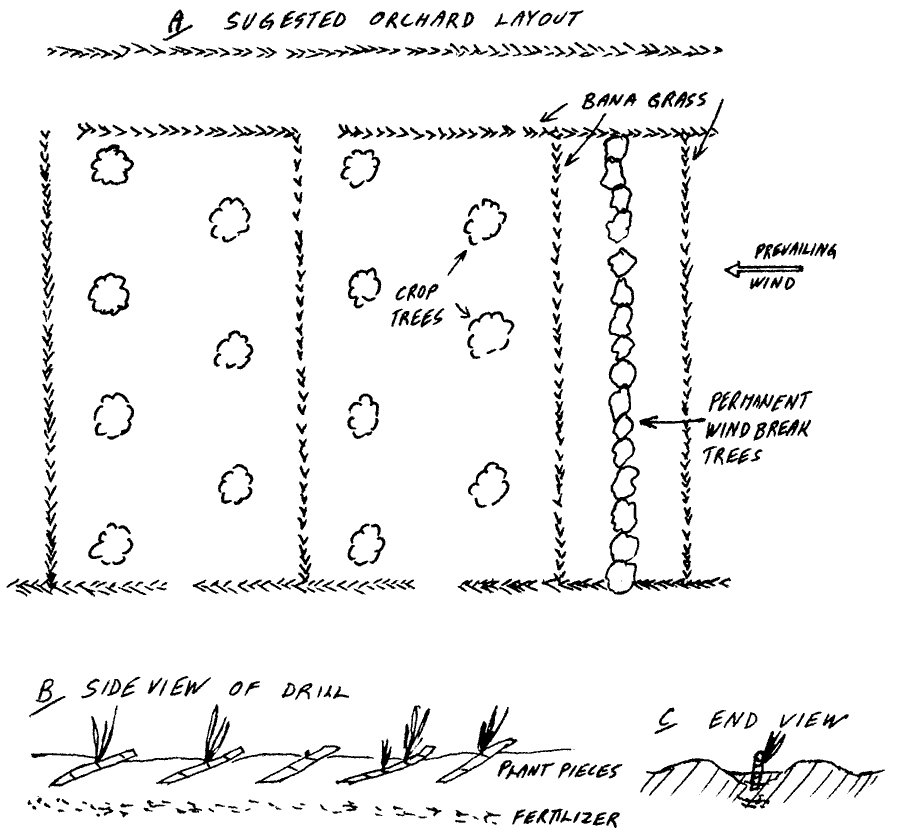
BANA GRASS - TEMPORARY WINDBREAK FOR ORCHARDS
Pennisetum purpureum x P. americanum
Most tropical fruit trees require protection from wind to achieve best growth, increased fruit set and reduce skin blemish on fruits. Our rambutans were planted on a flat wind-blown cane paddock. For immediate wind protection, we erected individual windbreaks around each planting site, approx. cost of $8 each for materials and many hours of work. Within a year the trees have outgrown the windbreaks.
While planting the trees I also planted Bana grass around the perimeter of the orchard and between every two rows of trees. Within 4 months the bana grass was taller than the trees and growing rapidly. The bana grass and trees have withstood many days of 25-30 knots SE and NE winds without significant damage.
Bana grass is a plant with a growth habit similar to sugar cane, reaching a height of 3m on the coast and even taller on the Tablelands. It grows erect and retains the old dead leaves (trash) to form an effective wind screen.
The Bana grass hybrid was originally produced in South Africa as a stock food plant. Its parents are Pennisetum purpureum - Elephant Grass and Pennisetum americanum - Pearl Millet. Kikuyu grass, Pennisetum clandestinum is also in the same genus.
Planting
A reliable planting method is:
(a) Mark out and plough a shallow drill (100 mm deep)
(b) Apply a handful of preplant fertilizer (Q4 or similar) per metre of row. Ensure the fertilizer is covered by 30-50 mm of soil to reduce burn on the young roots.
(c) Select and trim planting cane and distribute canes end on end, along the drill.
(d) Chop the cane into 30 mm lengths (2- 4 eyes) and either (i) cover with no more than 50 mm of soil (deeper planting may reduce germination), or (ii) position each piece of cane on an angle so that the lower end is covered with soil and the top eye is on the surface (see Diagram B).
Planting Conditions and After Care
To ensure best strike, resulting in an efficient windbreak, plant bana grass during warmer months when regular rain is about or irrigate at weekly intervals. Side dressings of a nitrogen fertilizer, (urea, sulphate of ammonia or similar) at a handful per metre of row 2-3 times a year and preferably while rain is about, will promote leaf growth.
Gaps in the row should be filled by planting extra cane as soon as possible. Bana grass roots develop quickly and if well-established will reduce the vigour of sets planted well after the gaps are obvious.
Slashing or cutting of the row of bana grass each year or two will rejuvenate and thicken the windbreak. Apply a handful of planting fertilizer per metre after cutting back to promote rapid regrowth.
Alternative Planting Method
With a single furrow plough, open a drill 100-200 mm deep. From a moving vehicle, trailing a piece of rail to cover, put down the fertilizer and throw out the canes. Walking along with a cane knife, place the lengths of cane in the drill and chop into 300 mm pieces - especially the top ends of the cane to prevent them curling up and drying. After this drive the tractor wheel up the drill and hope for continued rain.
Beware of:
(1) Other grasses that look like bana grass. There are some similar grasses that are not as suitable and possibly undesirable.
(2) Position of Planting
Keep rows of bana grass at least 5m from trees (remember that a good windbreak will provide some protection for a distance 15 to 20 times the height of the windbreak).
(3) Position of permanent windbreaks
When planting your orchard ensure you leave sufficient room for permanent windbreaks as bana grass is recommended as a 1-6 year temporary windbreak. Permanent tree windbreaks should be planted and cared for to be ready to take over.
(4) Seeding
Bana grass was developed as a sterile hybrid but in some areas a small amount of seed appears fertile. These seeds may spread for at least 10 metres. Seeding is usually in late spring. Seeds germinate in moist ground but are easily removed by pulling, chipping or regular slashing.
(5) Root invasion
A deep ripping along alternate sides of the row each year will prevent roots from competing with fruit trees.
Removing Bana Grass
Slash the rows and spray the regrowth when it is 1 to 1.5 m high with the herbicide, glyphosate (Roundup ®) or slash and rotary hoe.

DATE: September 1983, January 1994
* * * * * * * * * * * * *
